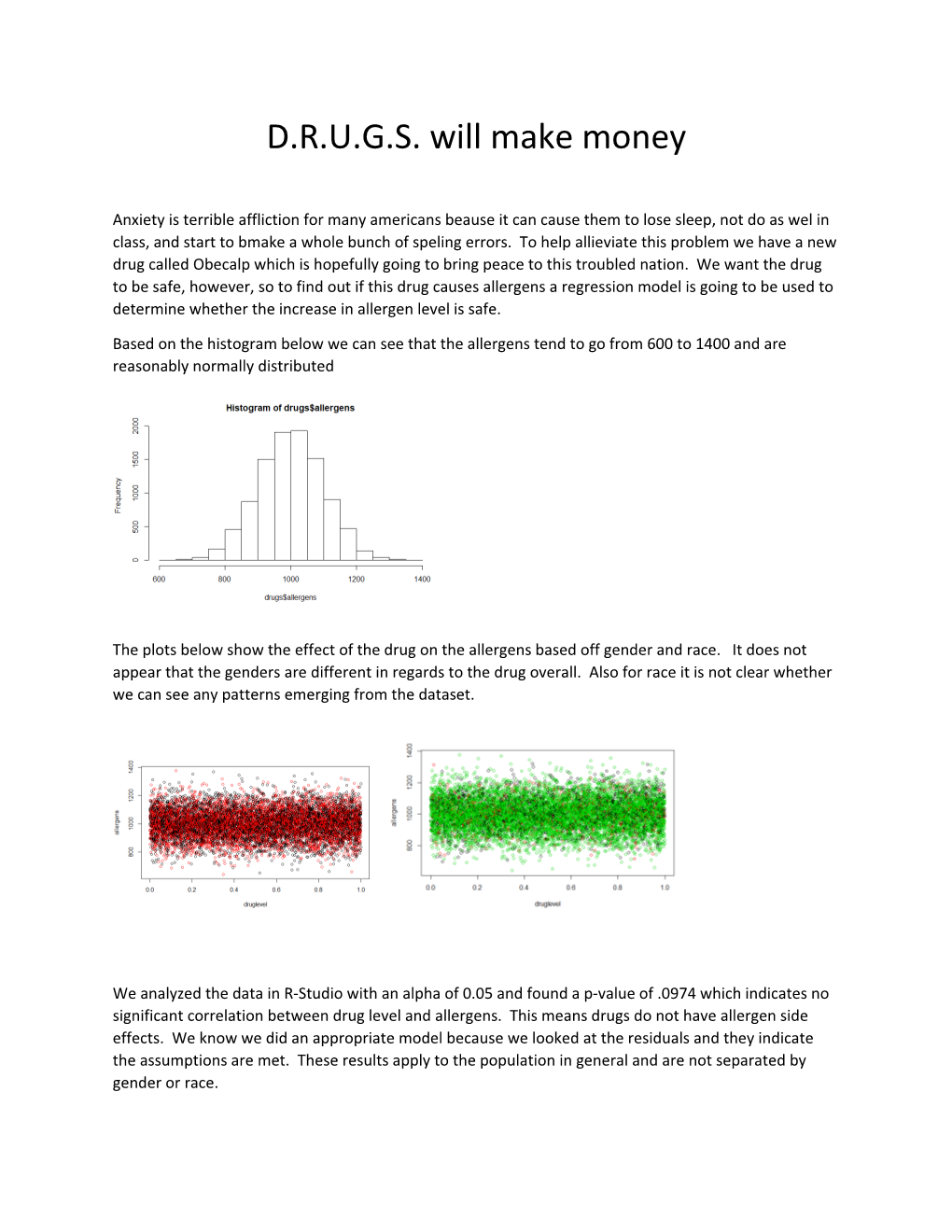D.R.U.G.S. will make money
Anxiety is terrible affliction for many americansbeause it can cause them to lose sleep, not do as wel in class, and start to bmake a whole bunch of speling errors. To help allieviate this problem we have a new drug called Obecalp which is hopefully going to bring peace to this troubled nation. We want the drug to be safe, however, so to find out if this drug causes allergens a regression model is going to be used to determine whether the increase in allergen level is safe.
Based on the histogram below we can see that the allergens tend to go from 600 to 1400 and are reasonably normally distributed
The plots below show the effect of the drug on the allergens based off gender and race. It does not appear that the genders are different in regards to the drug overall. Also for race it is not clear whether we can see any patterns emerging from the dataset.
We analyzed the data in R-Studio with an alpha of 0.05 and found a p-value of .0974 which indicates no significant correlation between drug level and allergens. This means drugs do not have allergen side effects. We know we did an appropriate model because we looked at the residuals and they indicate the assumptions are met. These results apply to the population in general and are not separated by gender or race.
When we included the race and gender effects, we can see the allergen level is affected, so it matters. To see the effect of the drug on the allergens for each demographic, the following prediction equations are helpful.
Asian Females: Allergens = 990.027 + 25.54 *druglevel
Asian Males: Allergens = 1006.678 + 17.873 *druglevel
Black Females: Allergens = 1017.743 - 40.944 *druglevel
Black Males: Allergens = 992.916 + 22.302 *druglevel
White Females: Allergens = 1004.92 – 6.992 *druglevel
White Males: Allergens = 996.549 - 2.001 *druglevel
The differences between these groups are significant as proven by the p-values which are all below alpha of 0.05. There were two exceptions: One was the effect of drug*gender, which shows that overall there is not a significant difference in how the drug affects allergens for men and women overall. To see the difference you have to break the population up by race. The other effect was the drug*white*male effect, which means that the slope for the white males is a combination of the effect from being white and the effect of being male separately.
Here is a plot of the effect of the drug on each demographic:
As you can see for Asians their allergens increase with the drug. For black women their allergens will decrease while for black males it will increase. For whites the allergens decrease, but not enough to care. It’s important to notice that these increases and decreases are so tiny that there isn’t much of an effect at all. With allergens ranging from 600 to 1400 having an increase of 25 allergens is practically insignificant.
I would recommend marketing this drug to black females and whites because for them it actually decreases their allergen level. For Asians and black males perhaps you should include a warning that it could have a slight allergic reaction. The R^2 was .004449 which means less than 1% of the variability in allergens is explained by the drug. This means there’s a lot of variability of the data around the regression line. It’s going to be super hard to make a prediction with this model. The standard error is 99.32 which means our predictions are easily off by 100, which is a big amount error when the effect of this drug is only 25 at most.
I would recommend to the FDA that this drug is ok, and there is not cause for concern about allergens. There may be a need for a warning of a possibly slight side effect on the box. This is great news because this drug could help a lot of people be less anxious. We might recommend that researchers do additional testing with more racial groups and other side effects.
